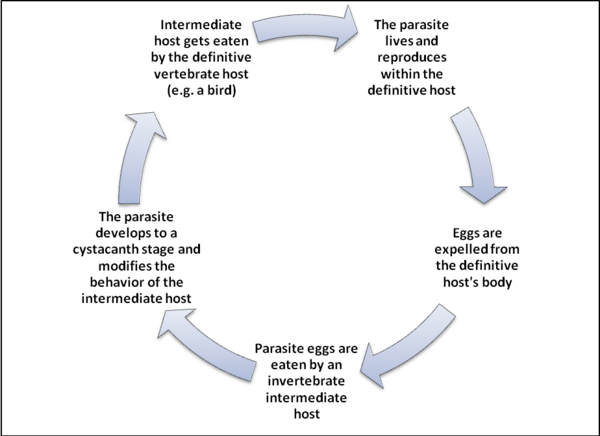| << Chapter < Page | Chapter >> Page > |
The acanthocephalans are one of the smallest and least diverse metazoan parasites, yet they can be found on all continents and in a variety of environments, including sea and fresh water (Kennedy 2006). They are thorn-headed parasitic worms whose life cycle requires two hosts. They begin their development when an intermediate host (typically an isopod, amphipod, or an insect) inadvertently consumes the acanthocephalan eggs . Once inside, the parasite grows in the host’s alimentary canal, avoiding significant mechanical damage to the host’s body. Once the parasite reaches the cystacanth stage, it needs to transfer to a new, definitive, vertebrate (generally a bird or a fish), in order to be able to reproduce and complete its life cycle. Inside the definitive host, they reproduce sexually and the eggs are released with the host’s feces. The transfer requires that the definitive host consume the intermediate host (Bierbower et al 2007, Benesh et al 2008, Moore 1983, Kennedy 2006).
The cystacanths do not leave such a crucial step in their life cycle to fate and work to modify the behavior and physiology of the invertebrate so as to maximally increase their chance of being eaten by the definitive host (Bakker 1997). The parasite makes the intermediate host more vulnerable to predation by variety of ways such as by decreasing its stamina, making it highly conspicuous, making it disoriented, and inversing its responses to environmental stimuli that indicate definitive host presence (Moore 1983). For acanthocephalans like Pomphorhynchus laevis, the level of behavior manipulation is higher if two parasites infect an individual rather than one, but the manipulation level does not increase for higher number of parasites. They cystacanths also have to be of the right age during transmission, i.e. older than 30 days. If they infect the definitive host too early, they might not be able to remain in the intestine. On the other hand, they usually do not survive longer than a year if not passed on to the next host (Kennedy 2006). Behavioral changes are more intense if the host is infected with older cystacanths (Franceschi 2008), reflecting the urgency to move on.

The size of the parasite population may follow an annual cycle (Brattey 1988). For instance, adult Acanthocephalus lucii living in Scotland are most abundant in late spring and summer, decline in numbers during autumn, and reach a minimum during winter. There is only one generation per year and there is a continual flow of parasites through the population of its final host, the European perch, Perca flaviatilis. The cycle may be driven by seasonal changes in the number of infective larvae, host’s resistance to infection, or host feeding behavior (Brattey 1988).
Along with serving as a mode of transmission to the final host, the intermediate host’s other role in the parasite’s life is as a source of nutrients. It is in the parasite’s interest to consume as many nutrients (i.e. eat as much of the host) as possible in order to grow and develop, but it is also in its interests to keep the host alive and fit, in order to escape predation until the parasite is ready to be transmitted. Thus, the parasite must find an optimum level of exploitation that maximizes growth and also maximizes the chances eventual of predation on the host (Benesh 2000). One method of dealing with this conflict is to infect a larger host in the first place, so that there are more nutrients to consume and more room to grow (Hasu 2007).

Notification Switch
Would you like to follow the 'Mockingbird tales: readings in animal behavior' conversation and receive update notifications?